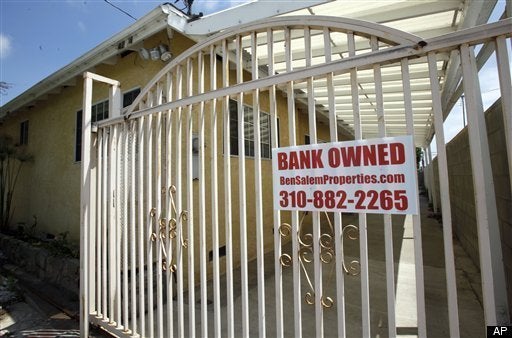
WASHINGTON -- Economists at the New York Federal Reserve have concluded that a controversial 2005 law backed by banks and credit card companies pushed more than 200,000 people into foreclosure and exacerbated the subprime mortgage crisis.
Consumer advocates fought hard against the law, which made it much more difficult for individuals to alleviate credit card debt in bankruptcy. This inability of homeowners to eliminate other debts, the New York Fed economists conclude, in turn made borrowers unable to pay off their mortgages, spurring foreclosures.
Despite opposition from public interest groups, the 2005 law easily cleared both chambers of Congress and was signed into law by President George W. Bush. In a paper released Tuesday, New York Fed researchers Donald P. Morgan, Benjamin Iverson and Matthew Botsch determined that the law sparked about 116,000 additional subprime mortgage foreclosures a year after going into effect.
What's more, they note, these foreclosures pushed home prices down, which may have lead to additional foreclosures. When the value of a home drops below what a borrower owes on the mortgage, it becomes nearly impossible to get out of the loan by selling the house or refinancing, making foreclosure more likely if they become unable to afford the monthly payment.
"By making it harder for borrowers to avoid paying credit card debt, [the 2005 bankruptcy law] made it more difficult for them to pay their mortgages, so foreclosure rates rose," the economists wrote.
Although borrowers have been unable to alleviate mortgage debt in bankruptcy since 1993, they remain able to discharge credit card debts by filing for bankruptcy. But the 2005 law made it much more difficult for consumers to file for bankruptcy at all -- and then limited their ability to reduce credit card debt burdens once they did.
By contrast, banks had long been able to dramatically increase consumer debt burdens without a borrower's consent at the time the bankruptcy law was passed. Through a practice known as "retroactive rate increases," a borrower could accumulate credit card debt at a low interest rate only to see the bank raise the interest rate on that debt later. Congress passed new rules governing the credit card market in 2009, banning this practice, among others.
The bankruptcy bill had substantial bipartisan support. In the Senate, 18 Democrats, including current Vice President Joe Biden, then a senator from Delaware, joined unanimous Senate Republicans in endorsing the legislation. Biden represented a state dominated by credit card interests, and his son Hunter Biden is a former executive for credit card behemoth MBNA, now owned by Bank of America. During the debate over the 2005 bill, Hunter Biden was a paid consultant for MBNA. New York Democratic Sen. Hillary Clinton, now Secretary of State, missed the vote on the Senate floor because Bill Clinton was undergoing heart surgery, but had supported earlier versions of the legislation. Then-Sen. Barack Obama (D-Ill.) opposed the bill on final passage.
But while the New York Fed economists noted that the increase in foreclosure rates was predictable at the time the law was passed, they stopped short of calling for its repeal. The economists contended that since people now know that consumer debt is hard to discharge in bankruptcy, they will not take on as much debt and end up in financial distress.
"Once borrowers have learned that the bankruptcy rules have changed, they can be expected to reduce their demand for unsecured debt," Morgan, Iverson and Botsch wrote.
But if consumer financial problems are being driven by factors relatively difficult for consumers to control -- such as a loss of income following a layoff -- the 2005 law may well continue to promote foreclosures. Longtime critics of the 2005 law, including then-Harvard University Law School Professor Elizabeth Warren, who is currently charged with setting up the Consumer Financial Protection Bureau, have emphasized that consumption binges do not explain the high levels of consumer debt and financial distress seen in recent decades.
In an article published by The Boston Review shortly after the 2005 law was passed, Warren argued that flat wages and higher essential household expenses were squeezing the middle class into bankruptcy-- more expensive mortgages due to rising home prices, alongside higher health care costs and higher tax burdens.
"[Household spending data provide] powerful evidence that excessive consumption is not why families are going broke," Warren wrote. "There is no evidence of any 'epidemic' of overspending."
Articles published by economists at regional Fed offices are not endorsed by the Fed's Board of Governors, the dominant policymaking arm of the central bank.
